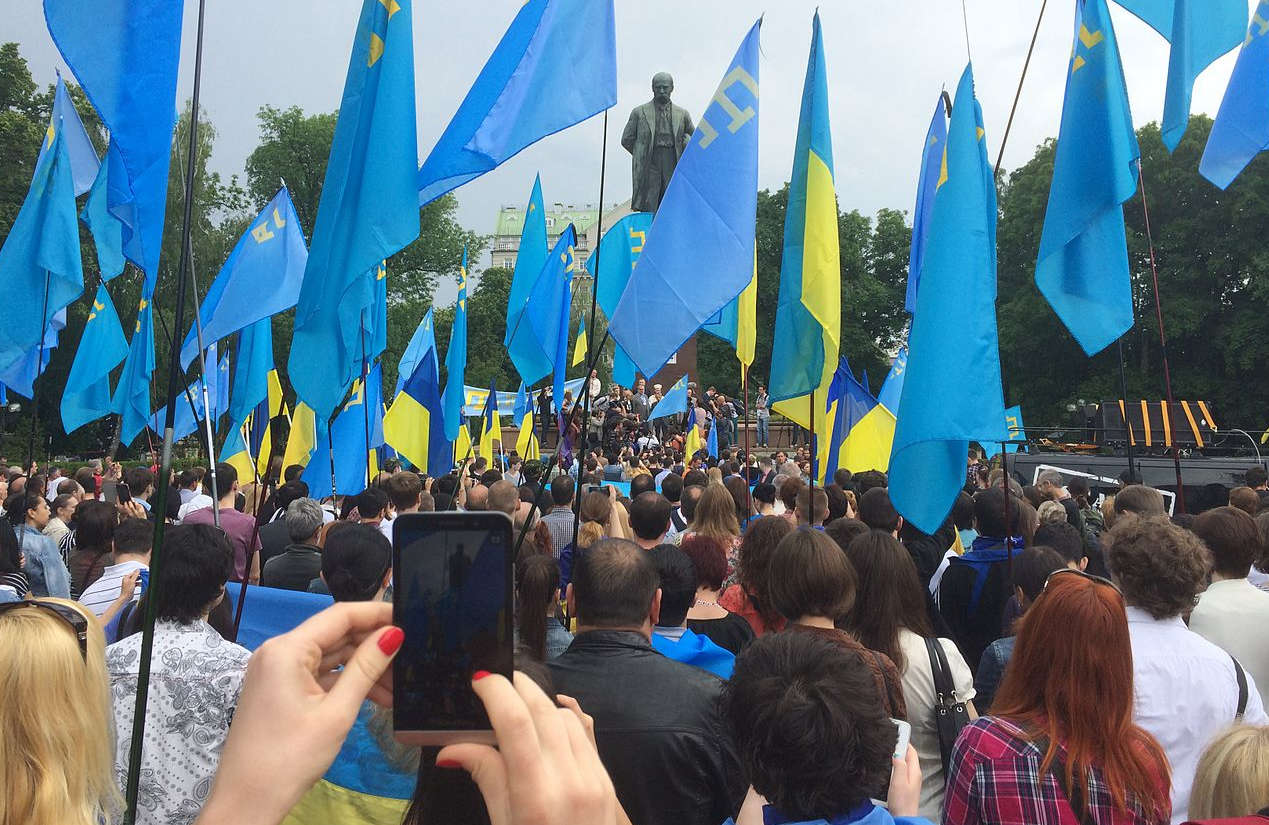Kyiv, Ukraine (VIAnews) – The first episode of the Tatars’ rights restraint took place after the Russian Empire annexation of the Crimean peninsula from the Ottoman Empire in 1783. The new government seized lands and properties, using its power to deprive Crimean Tatars of their rights, which caused a mass migration to the Ottoman Empire.
The second tragic period in the Tatars’ history had begun after the Second World War while more than 200 thousand locals were forcibly deported from the peninsula. In 1944, the Soviet government accused the Crimean Tatars of collaborationism with Nazis and forced them to leave their homes and motherland. People were deported to the Kazakhstan, Uzbekistan, and Mari Autonomous Soviet Socialist Republic without rights to come back into Crimea. Lately, Ukrainian authorities have declared these deportations as the genocide of the Crimean Tatars.
Only in 1989, just before the Soviet Union collapsed, were the Tatars allowed to return to their homes. However, it was hard to call “home” to houses and properties that are no longer their own. Nonetheless, the Crimean Tatars came back and tried to start a new life. Indeed, they succeeded.
Ukrainian authorities accepted the autonomous ethnic group in the country and empowered them with the right of self-determination. The Tatars used this right by launching Mejlis, a parliament-like representative institution of the Crimean Tatars, building mosques, and opening Crimean Tatar’s schools. Crimean Tatars accepted to be a Ukraine autonomous ethnic group and to participate as the full-fledged citizens.
In 2014 everything changed. After the invasion of the Russian Federation and annexation of the Crimean peninsula, the new government launched an illegal referendum. While many Crimeans supported such transformation, the official position of the Crimean Tatars was strongly against it. Remembering mass-deportation and the years of exile, they insisted that Crimea is part of Ukraine.
Today they pay dearly for such position.
The first case of the Crimean Tatars activists disappearance took place in 2014. March the 15th is considered the starting point of the Crimean Tatars’ repression. That day, Reshat Ametov, a 39 years old Tatar, was found murdered near the Crimean village Zemlyanichnoe. His body was covered with numerous marks of beatings, the head was tied with adhesive tape, and the handcuffs were lying nearby. The death was caused by the stabbing in the eyes. Few weeks before, Reshat was taking part in the manifestation against the Russian troops invasion to the Crimean peninsula in Simferopol city. The tape from the surveillance cameras depicted a men, wearing the uniform of the Crimean self-defense organization, pushing Ametov into a car. That was the last vestige of Reshat Ametov being alive.
One of the most obvious reasons for the Russian repression concerning Crimean Tatars is the ardent disobedience of this ethnic group. This loud and strong rejection of the Russian aggression hinders the assimilation of the peninsula citizens by the Russian Federation. Thus, invader’s government takes more severe and sophisticated steps to strangle the insubordination.
For the last three years, self-proclaimed officials of Crimea exert pressure not only to Tatars activists but also to the official institutions and Tatars political leaders.
In 2014, the de-facto Crimean authorities issued a resolution that forbids to cross the Russian and Crimean borders. Mustafa Dzhemilev and Refat Chubarov were political and spiritual leaders of the Crimean Tatars. During the Soviet Union, they were dissidents, fighting for the restoration of the Crimean Tatars’ sovereignty. After 1991, Dzhemilev became the head of Mejlis, while Chubarov was its deputy chairman. They were also representing the Crimean Tatars on the international stage. The forbiddance to enter the Crimean territory became the first internationally known fact of the ethnic repression organized by the Russian government.
One year ago, in April 2016, a new tragic event took place at the Crimean peninsula. The self-determined government recognized Mejlis as an “extremist organization” and suspended its activity. Such decision provoked a huge wave of indignation. Denis Krivosheev, the Amnesty International Deputy Director for Europe and Central Asia, claimed that “the decision to suspend the Mejlis of the Crimean Tatar People and ban all its activities under Russia’s anti-extremism legislation is a repugnant punitive step denying members of the Crimean Tatar community the right to freedom of association”.
However, the repression of the de-facto Crimean government is not over.
One month ago, Akhtem Chiygoz, Crimean Tatar politician, deputy chairman of the Mejlis, was sentenced to eight years in a colony of strict regime. He was charged with the organization of the mass riots. Man’s last words in court were: “This court is organized by the invader country, which has no right in it. In such situation, knowing all the true intentions of the process coordinators, there is no need mention the objectivity and independence of the court. I am destined to accept this sentence as a verdict for the entire Crimean Tatar people – on behalf of the Russian Federation that occupied my Motherland”.
Another flashy process took place in Crimea two weeks ago. The case of Ilmi Umerov is similar to Chiygoz’s situation. The man was suspected of committing public appeals and actions aimed at changing the territorial sovereignty of Russia. 52-year-old Umerov, another active member of Mejlis, was sentenced to two years in the colony of strict regime.
Obviously, all these processes are aimed to deprive the Crimean Tatars of their ideological leaders, as well as, to suppress the pro-Ukrainian mood among this ethnic group. According to the NGO “Crimea SOS”, since the beginning of Crimean annexation by the Russian Federation, 44 people have been forcibly disappeared at the peninsula. Today, 17 people were released, 6 were found dead, 2 were imprisoned and sentenced, and 18 people are still not found.
Nonetheless, some Crimean Tatars support the new government. Part of them have obtained the Russian citizenship and started cooperating with the new regime. Russian newspaper Novaya Gazeta has met with the opponents of the Ukrainian direction. For instance, Lenur Usmanov, an active supporter of the Communist Party of the Russian Federation (CPRF), said that, for him, Crimea was always a part of Russia and all repression was caused by the genuine extremist activities of the Tatar activists and organization.
Vasvi Abduraimov, another Crimean Tatar activist, headed the department for the return of the Crimean Tatars to their homeland during the 90-s. Today he tends to create the analogy to Mejlis, which would be able to cooperate with the new authorities. He claims that in 2014, 30% of the Crimean Tatars supported the Russian annexation. Meanwhile, the man stated against the repression of his political opponents, calling all these processes a “circus”.
The completely different opinion was declared by those Crimean Tatars who now live in the territory of continental Ukraine. Some of them actively boost the idea of the Crimean Tatars Autonomous Republic. However, such idea might lead even more convoluted consequences, even when Crimea would be controlled by Ukraine.
The international society has been expressing high concerns about the Crimean Tatars’ rights violation. For instance, the parliament of the European Union at a plenary meeting in Strasbourg adopted a resolution, accusing Russia of human rights violation in the territory of the annexed Crimea, and primarily, the rights of the Crimean Tatars.
Unfortunately, the situation has not changed. The repression and the forced disappearance have signified the beginning of the third dark period for the Crimean Tatars.







